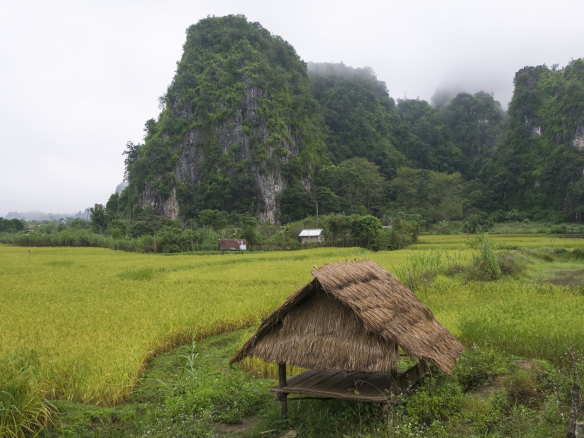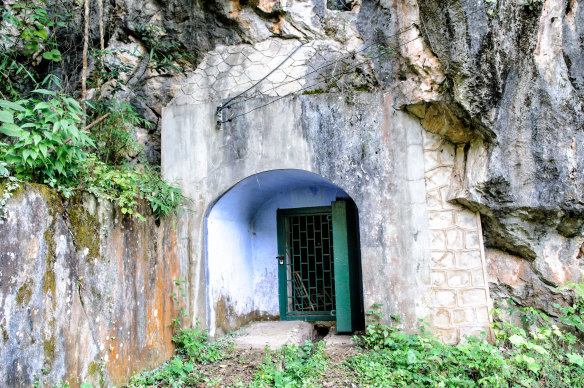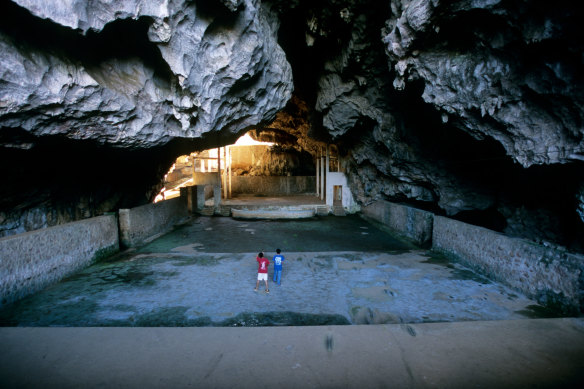The secret underground city the US tried to bomb out of existence
By Kurt Johnson
How long you’ve been in Laos will decide how you react to Viengxay’s landscape.
To new arrivals, bungalows nestled between towering misty limestone peaks will constitute an achingly beautiful sight but to the acclimatised, this is just more Northern Laos.
And that’s the point. Viengxay was a secret underground city used by the Lao Communist Party (Pathet Lao) between 1964-73, to provide shelter from Yankee bombs, allowing the upper echelons here to conduct a revolution and win a civil war. At its height, 20,000 people lived in what was renamed from The Special Zone in 1970 to Viengxay – or City of Victory.

To new arrivals, bungalows nestled between towering misty limestone peaks will constitute an achingly beautiful sight.Credit: Getty
I hand over 60,000 kip ($5) admission below the stern gaze of the communist high command portraits. As today’s only English speaker, Bun is my personal guide. He is tall, reserved and has excellent English, but is helped by a pre-recorded audio guide outsourced to Sydney company Narrowcasters, meaning narration is in the smoky cadence of an ABC documentary.
The tour covers a series of different mountains dotted throughout what has become a modern village. Each hosts a “building” named as if the cavernous systems within was an external structure. The first, built into a sheer rock cliff, is the Meeting Place of the Central Committee. Entering through a discrete opening, I smell damp. Despite those stationed here at the apex of the hierarchy, the furniture is unvarnished, the only adornment on the rough walls are faded strategic maps.

A discreet entrance to the hospital caves.Credit: Alamy
Further in are guardrooms and bedrooms with bare wooden bunks. Back outside a kitchen alcove is still soot-marked. Cooking was done sparingly as smoke would attract bombs, Bun explains.
Victory was possible only through assistance from other communist states: Vietnam, the USSR and China provided equipment, strategy and revolutionary direction. The sealed bomb shelters sport Russian air pumps in case of a gas attack (never needed) while the Viet Cong trained Lao soldiers to distinguish between spotter planes, fighters and bombers.
Through caves and gardens then more caves, I begin to accept that this is really a city. There are administrative buildings, houses, an immense theatre, garrisons, banks, a baker, schools and even space for a circus troupe. Yet Viengxay was not entirely self-contained. Crops need sunlight and had to be planted, tended and harvested outside, where the only cover was night.
When the bombs fell they were indiscriminate. Bun defers heavily to the audio guide which explains how the Lao realised bright colours would attract bombs. So too the white feathers of ducks or chickens. They were correct: interrogating a downed US pilot revealed his orders were not to attack a specific target but to bomb chickens and ducks to kill the Lao nearby.

The huge cavern that served as a theatre.Credit: Alamy
Bun and I overlap other groups. A group of Thai tourists are dressed fashionably, even flashily – evidence of a different national arc. A Lao group ambles unguided, wearing similar clothes to those in the nearby village.
I ask Bun if Americans visit.
“No, not many. I think it is difficult for them to hear,” he replies.
Later he shows a video on his phone of Obama’s 2016 trip to Laos, where the former president acknowledged the Secret War. While his speech opts for the passive voice – “bombs were dropped” instead of “we dropped bombs” – any recognition was clearly important to Bun, whose mother saw the bombs firsthand.
“Only here do I truly understand that people lived in this place, rather than just survived.”
“She was in a field when one plane dropped a parachute with a light then the bomber dropped bombs on that target,” he explains.
We climb to a lookout that had been an anti-aircraft battery. Nightly raids have blown off the entire top of the mountain, now noticeably shorter than those surrounding. The field it overlooks is cratered. Still the landscape retains its beauty. Viengxay is cold by Lao standards and the mist stays late while lingering damp breeds colourful moss that covers rock. Structures built after victory complement the battered landscape – one bomb crater was converted into a Koi pond in the shape of a broken heart.
Some symbolism is more sombre. “These are called blood leaf,” says Bun pointing to red plants growing in all our stops. “They were planted to represent the blood that was spilled.”
So why brave the slow and perilous 16-hour minivan journey from Luang Prabang to visit here and not just read a book? Only inside these stony warrens can you experience the clamminess of the underground and appreciate the thousand mini-trials involved: bumping your head again on a low sharp rock, slipping on a slimy patch or struggling up the rickety stairs to an antiaircraft battery to feel the vulnerability beneath the sky.
But it is at our last stop when the penny really drops: a huge cavern that served as a theatre – with world-class acoustics. Here films were screened, plays performed and weddings celebrated. Whereas the other “buildings” were dedicated to utility and collective striving, this was reserved for recreation. Only here do I truly understand that people lived in this place, rather than just survived. I thank Bun, hand back my audio guide and carry this back out into the sunlight.
Getting there
There is no easy way to get to nearby Sam Nuea, despite it being the provincial capital. The roads are bad and the buses from Vientiane or Luang Prabang are excruciating. One alternative is to cross from Hanoi in neighbouring Vietnam. There is also a plane from the capital via Lao Skyway but tickets must be booked in person. From Sam Nuea ask at your hotel for a taxi, $40 per day, all included.
The writer travelled at his own expense.
Sign up for the Traveller Deals newsletter
Get exclusive travel deals delivered straight to your inbox. Sign up now.